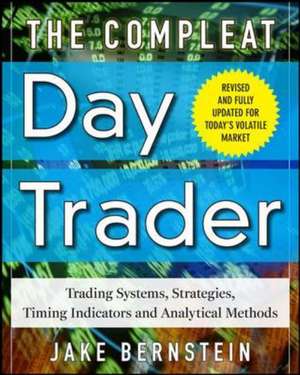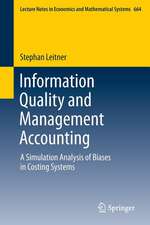The Compleat Day Trader, Second Edition
Autor Jake Bernsteinen Limba Engleză Hardback – 16 feb 2011
THE BOOK DAY TRADERS RELY ON TO CAPTURE PROFITS AND LOWER RISK
Since The Compleat Day Trader was first published, the tools available to day traders have become incomparably more efficient and effective, thereby dramatically increasing your chances of success. On the flip side, day trading is much riskier and faster paced than ever before. Staying current isn't an option for the serious day trader--it's an absolute necessity.Jake Bernstein has revamped his bestselling guide, The Compleat Day Trader, to bring you fully up to date on his trading model, methods, and indicators, all of which are designed to help you take advantage of dramatically increased volatility in the global stock, futures, and forex markets.
In order to generate profits consistently, you need to define your intraday time frames, implement a specific trading model, and develop objective and operational procedures.
The Compleat Day Trader walks you through these critical processes step by step to help you execute with focus, logic, and objectivity--no matter how volatile the markets may be. Bernstein’s powerful and clear tools aredesigned to give you the advantage you'll need. Learn about his:
- MA Channel Swing Trade with Triggers and Setups
- MAC Patterns and Signals
- Power Momentum Day-Trade Formula
- MACD Divergence Setups and Triggers
- Gap Day-Trade Method
- Profit-Maximizing Strategies
- Media Day-Trade Strategy
This refreshed, updated edition of The CompleatDay Trader provides you with the knowledge you need to make handsome profits while lowering your exposure--so you can rise to the top echelon of day traders.
Preț: 288.04 lei
Preț vechi: 318.55 lei
-10% Nou
Puncte Express: 432
Preț estimativ în valută:
55.12€ • 59.86$ • 46.30£
55.12€ • 59.86$ • 46.30£
Carte tipărită la comandă
Livrare economică 24-30 aprilie
Preluare comenzi: 021 569.72.76
Specificații
ISBN-13: 9780071663885
ISBN-10: 0071663886
Pagini: 240
Dimensiuni: 196 x 241 x 20 mm
Greutate: 0.6 kg
Ediția:2. Auflage.
Editura: McGraw Hill Education
Colecția McGraw-Hill
Locul publicării:United States
ISBN-10: 0071663886
Pagini: 240
Dimensiuni: 196 x 241 x 20 mm
Greutate: 0.6 kg
Ediția:2. Auflage.
Editura: McGraw Hill Education
Colecția McGraw-Hill
Locul publicării:United States
Cuprins
Preface
Acknowledgments
1. Where We Have Been and Where We Are Going
What Follows
The Forces and Factors behind Record-Breaking Volatility
The Electronic Revolution and Trading
Day Trading Is More Viable than Ever
2. The Basics: Definitions, Tools, and Considerations
Does a Day Trader Trade “Anything That Moves”?
Why Day-Trade?
What You Will Need
3. The Trading Model: Setup, Trigger, and Follow-Through
Market Structure
A Closer Look at the STF Structure
Conclusion
4. Trading System Development and Testing
System Development
What Is a Trading System?
Taking a Random Walk
What’s Left?
Markets Change; Market Participants Change
Striving for Solutions
The Role of Artificial Intelligence
Implications for the Future
5. Day Trading with Moving Averages
Moving Average Basics
Traditional Moving Systems: Assets and Liabilities
The Final Analysis
6. Day Trading with Support and Resistance: The Moving Average Channel
Overview of the Moving Average Channel
Step-by-Step Procedures for Day Trading with My MAC
Opportunities: Conservative and Aggressive
Profit-Maximizing Strategies with the MAC Method
A Few Precautions and Suggestions
Is the MAC Totally Objective?
Using the Channel Technique with Other Methods
Evaluation of the MAC
7. The Media Day Trade
A Typical Media Day Trade Scenario
Typical Behavior
Procedure for Making Media Day Trade
A Closer Look at Exit Strategies
8. Day Trading with Momentum and MACD
What Is Momentum?
What Momentum Can Do for You
General Characteristics of Momentum
Momentum Divergence
Momentum Is a Leading Indicator
Momentum Timing: Signals
Identification of Momentum Buy Signals
Choosing the Sell Point after Bearish Momentum Divergence
Moving Average Convergence-Divergence as Trigger
Stop Loss and Profit-Maximizing Strategy
9. Day Trading with Gaps
Opening Gaps
Frequency of Opening Gaps
Gap Open Signals
Observations about Gap Day-Trade Rules
Psychology of the Gap Higher Opening and Sell Trade
Stop Losses and Follow-Up Stop Losses on Gap Trades
Alternate Gap Trade Exit Method
Delayed Gap Open Signals
Some Observations about the Gap Technique
Overview of Effective Rules and Procedures for Gap Trades
Get Some Experience
Gap Size and Penetration Size
What You Can Realistically Expect from Gap Trading
A Few Last Words about Stop Orders
Takeaway Points
10. Using the Eight Open, Eight Close Method
How the Eight Open, Eight Close Method Works
Another Application of the Eight OC Method
11. Profit-Maximizing Strategies
The Importance of Sufficiently Large Stop Losses
Increasing Profits through Position Size Management
Trade Management through Equity Filter Application
Some Salient Points
The Danger Zone Concept
Using a Moving Average as a Tailing Stop
Gap Trade Profit-Maximizing Strategies
Conclusions and Summary of Profit-Maximizing Strategies
12. The Psychology of Day Trading
Discipline: The Essential Ingredient
Persistence
Willingness to Accept Losses
The Ability to Avoid Overtrading
The Ability to Specialize
What Should the New Day Trader Trade?
Beginning with Sufficient Capital
The Ability to Use News to Your Advantage
Taking Advantage of Brief Price Surges
Sticking to Your Daily Goal
Using Market Sentiment to Find Day Trades
Conclusions
13. Losing Mistakes and Winning Behaviors
Losing Mistakes
Winning Behaviors
14. Putting It All Together
Organization
Concluding Remarks
Index
Acknowledgments
1. Where We Have Been and Where We Are Going
What Follows
The Forces and Factors behind Record-Breaking Volatility
The Electronic Revolution and Trading
Day Trading Is More Viable than Ever
2. The Basics: Definitions, Tools, and Considerations
Does a Day Trader Trade “Anything That Moves”?
Why Day-Trade?
What You Will Need
3. The Trading Model: Setup, Trigger, and Follow-Through
Market Structure
A Closer Look at the STF Structure
Conclusion
4. Trading System Development and Testing
System Development
What Is a Trading System?
Taking a Random Walk
What’s Left?
Markets Change; Market Participants Change
Striving for Solutions
The Role of Artificial Intelligence
Implications for the Future
5. Day Trading with Moving Averages
Moving Average Basics
Traditional Moving Systems: Assets and Liabilities
The Final Analysis
6. Day Trading with Support and Resistance: The Moving Average Channel
Overview of the Moving Average Channel
Step-by-Step Procedures for Day Trading with My MAC
Opportunities: Conservative and Aggressive
Profit-Maximizing Strategies with the MAC Method
A Few Precautions and Suggestions
Is the MAC Totally Objective?
Using the Channel Technique with Other Methods
Evaluation of the MAC
7. The Media Day Trade
A Typical Media Day Trade Scenario
Typical Behavior
Procedure for Making Media Day Trade
A Closer Look at Exit Strategies
8. Day Trading with Momentum and MACD
What Is Momentum?
What Momentum Can Do for You
General Characteristics of Momentum
Momentum Divergence
Momentum Is a Leading Indicator
Momentum Timing: Signals
Identification of Momentum Buy Signals
Choosing the Sell Point after Bearish Momentum Divergence
Moving Average Convergence-Divergence as Trigger
Stop Loss and Profit-Maximizing Strategy
9. Day Trading with Gaps
Opening Gaps
Frequency of Opening Gaps
Gap Open Signals
Observations about Gap Day-Trade Rules
Psychology of the Gap Higher Opening and Sell Trade
Stop Losses and Follow-Up Stop Losses on Gap Trades
Alternate Gap Trade Exit Method
Delayed Gap Open Signals
Some Observations about the Gap Technique
Overview of Effective Rules and Procedures for Gap Trades
Get Some Experience
Gap Size and Penetration Size
What You Can Realistically Expect from Gap Trading
A Few Last Words about Stop Orders
Takeaway Points
10. Using the Eight Open, Eight Close Method
How the Eight Open, Eight Close Method Works
Another Application of the Eight OC Method
11. Profit-Maximizing Strategies
The Importance of Sufficiently Large Stop Losses
Increasing Profits through Position Size Management
Trade Management through Equity Filter Application
Some Salient Points
The Danger Zone Concept
Using a Moving Average as a Tailing Stop
Gap Trade Profit-Maximizing Strategies
Conclusions and Summary of Profit-Maximizing Strategies
12. The Psychology of Day Trading
Discipline: The Essential Ingredient
Persistence
Willingness to Accept Losses
The Ability to Avoid Overtrading
The Ability to Specialize
What Should the New Day Trader Trade?
Beginning with Sufficient Capital
The Ability to Use News to Your Advantage
Taking Advantage of Brief Price Surges
Sticking to Your Daily Goal
Using Market Sentiment to Find Day Trades
Conclusions
13. Losing Mistakes and Winning Behaviors
Losing Mistakes
Winning Behaviors
14. Putting It All Together
Organization
Concluding Remarks
Index















